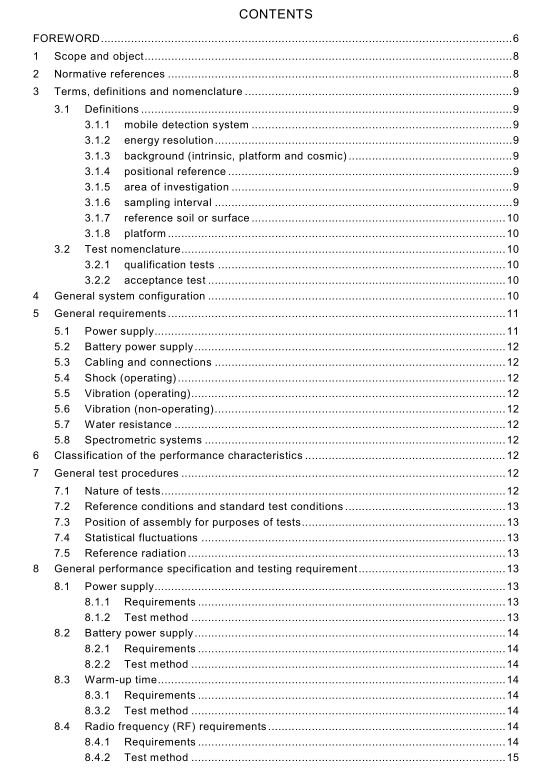IEC 62438 pdf – Radiation protection instrumentation – Mobile instrumentation for the measurement of photon and neutron radiation in the environment

IEC 62438 pdf – Radiation protection instrumentation – Mobile instrumentation for the measurement of photon and neutron radiation in the environment
IEC 62534,Radiation protection instrumentation – Highly sensitive hand-held instruments forneutron detection of radioactive material1
Iso 4037 (all parts),x and gamma reference radiation for calibrating dosemeters anddoserate meters and for determining their response as a function of photon energy
Iso 6980 (all parts),Nuclear energy – Reference beta-particle radiation
3Terms, definitions and nomenclature
3.1 Definitions
For the purposes of this document,the following terms and definitions apply. Except asspecified below, all technical terms are as defined in lEC 60050,particularly for radiationquantities and dosimetric terms defined in lEC 60050-393 and lEC 60050-394.
3.1.1mobile detection system
mobile detection systems consist of a suitable number of radiation detectors mounted on antransportable platform,which are capable of making measurements while moving (seeFigure 1).
NOTE This may include but is not limited to fixed and rotary winged aircraft, surface vehicles, ocean towing, andamphibious vehicles.
3.1.2energy resolution
the full width in percent or keV at half maximum at a defined total absorption peak (see AnnexA)
3.1.3background (intrinsic,, platform and cosmic)
the measured count rate from photons in an energy spectrum or a given energy window or themeasured count rate from neutrons from the detection system,platform and cosmic radiation(see Annex A)
3.1.4positional reference
the spatial reference which defines the location of the detection system in terms of acoordinate system and where necessary, altitude and the height above the surface
3.1.5area of investigation
the area from which 90 % of the detected photons and neutrons of interest are emitted,assuming a planar surface of uniform activity
3.1.6sampling interval
the time in seconds between the start of consecutive data samples or measurements. This isalso known as the integration time
3.1.8platform
for the purposes of this standard,platform refers to carrying system including aircraft,truckor person
3.2Test nomenclature3.2.1qualification tests
tests performed in order to verify that the requirements of a specification are fulfilled.Qualification tests are divided into type tests and routine tests.
a) type test: A test of one or more devices made to a certain design to show that the designmeets certain specifications.
b) routine test: A test to which each individual device is subjected during or after
manufacture to ascertain whether it complies with certain criteria.
3.2.2acceptance test
a contractual test to prove to the customer that the device meets certain conditions of itsspecifications
[IEV 151-04-20]
4General system configuration
The measurement system should consist of:
.A primary detection system that has variable sampling intervals (typically between 1 s and5 s) providing sufficient detector response to enable the detection,identification,andquantification of radionuclides of interest.
Navigation system to continuously measure the position of the detection system, enablingspatial resolution for mapping. For ground systems inertial navigation may be required inareas where there is poor GPS coverage.
Power supply for the detection system that may be part of the mobile platform or self-contained.
Multi-channel analyzer(s) for photon pulse height analysis with algorithms to provideradionuclide identification.
A data acquisition system that collects and stores radiation detection data,positionalinformation, time,and provides user interface and real-time display.
. Software for data viewing and basic analysis.
The measurement system may also include:
.A neutron detector to record the gross neutron count rate.
.For airborne systems these should also include radar altitude and may also include
ambient temperature, humidity and pressure, wind speed and direction.
For information purposes, primary detection systems comprise large volume Nal(Tl) detectors,although other scintillators may also be considered.For emergency response purposes,organic scintillators may also be considered for mapping total gamma emission.









